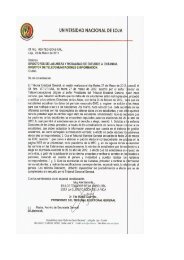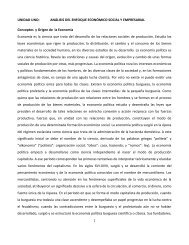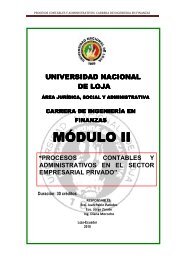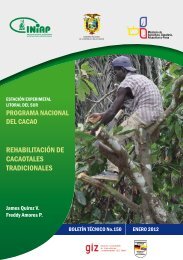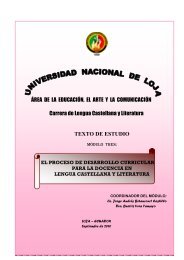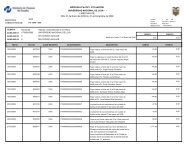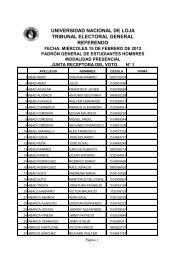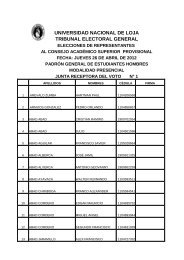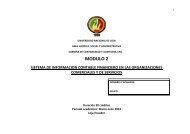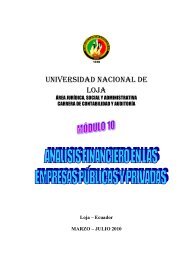module 5 planning of the english language teaching-learning process
module 5 planning of the english language teaching-learning process
module 5 planning of the english language teaching-learning process
Create successful ePaper yourself
Turn your PDF publications into a flip-book with our unique Google optimized e-Paper software.
UNIVERSIDAD NACIONAL DE LOJA<br />
Área de la Educación el Arte y la Comunicación<br />
English Language Career<br />
2 It is better to correct all <strong>the</strong> mistakes learners make.<br />
PRACTICE TASK<br />
For questions 1-6, match <strong>the</strong> teacher’s behaviour with <strong>the</strong> correction techniques<br />
listed A-B<br />
You need to use some options more than once.<br />
Teacher’s behariour<br />
Correction techniques<br />
A. Ignore <strong>the</strong> mistake<br />
B. Use self-correction<br />
C. Draw a time line on <strong>the</strong> board<br />
D. Use finger correction.<br />
1. You have used a correction code to show learners where <strong>the</strong>y have<br />
made mistakes in <strong>the</strong>ir writing. You now ask <strong>the</strong>m to correct <strong>the</strong>ir own<br />
mistakes. You now ask <strong>the</strong>m to correct <strong>the</strong>ir own mistakes.<br />
2. You are working with a class <strong>of</strong> elementary ten-year-olds who are doing<br />
a fluency activity. One <strong>of</strong> <strong>the</strong> learners is talking with a class about her<br />
pet. She says: ‘My rabbit eat lettuce. ‘You let her continue talking.<br />
3. You are doing a controlled practice activity. One <strong>of</strong> <strong>the</strong> learners says: ‘I<br />
have been working last week. ‘You show her a diagram.<br />
4. A learner is repeating <strong>the</strong> instructions for a activity and says: Then we<br />
choose/tri./(three) objects.’ You just listen.<br />
5. You are focusing on spoken <strong>language</strong> and <strong>the</strong> use <strong>of</strong> contractions. A<br />
learner says: ‘I am going swimming tomorrow, ‘You want to show her<br />
where <strong>the</strong> mistake is. You use your hand.<br />
6. An advanced learner asks you: ‘Can you borrow me a pencil, please?’<br />
You ask him to him to think about what he has said and to try again.<br />
Giving feedback<br />
<br />
How do we give feedback?<br />
Giving feedback is giving information to learners about <strong>the</strong>ir <strong>learning</strong>. Feedback<br />
can focus on learners' <strong>language</strong> or skills, <strong>the</strong> ideas in <strong>the</strong>ir work, <strong>the</strong>ir<br />
behaviour, <strong>the</strong>ir attitude to <strong>learning</strong> or <strong>the</strong>ir progress. Sometimes we give<br />
feedback to <strong>the</strong> whole class, at o<strong>the</strong>r times we give feedback to small groups or<br />
individual learners. The purposes <strong>of</strong> feedback are to motivate learners and to<br />
help <strong>the</strong>m understand what <strong>the</strong>ir problems are and how <strong>the</strong>y can improve.<br />
<br />
Key concepts<br />
[Escribir texto] Página 110



